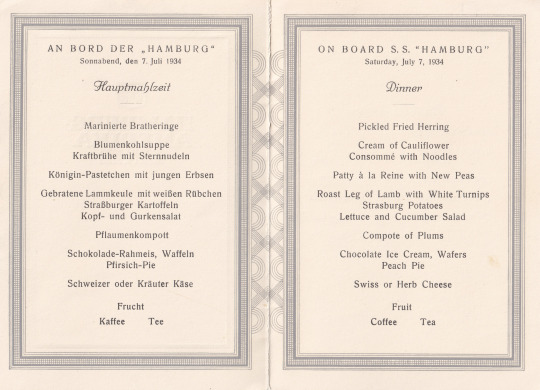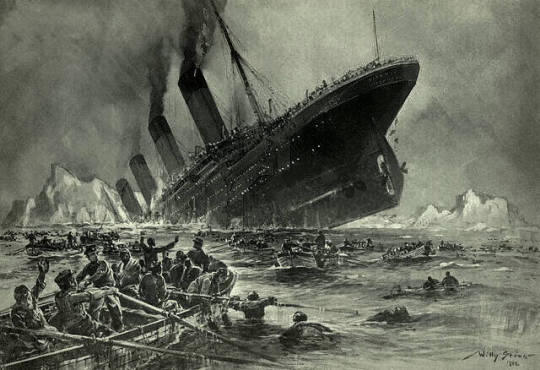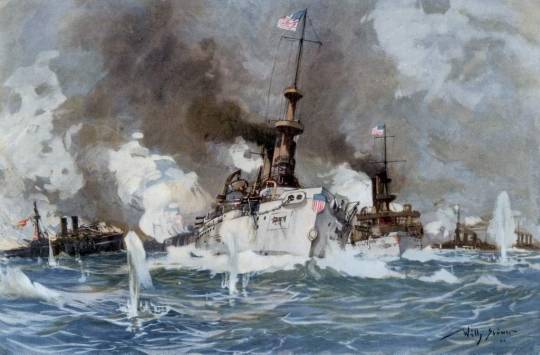#willy stöwer
Text



a large postcard depicting the s.s. hamburg in gudvangen, norway, along with the ship's dinner menu and music programs for july 7th, 1934.
art by willy stöwer, ca. 1920s.
#postcard#postcards#ocean liners#ss hamburg#hamburg america line#norway#art card#willy stöwer#1920s#1930s#the place+timing of this is odd. i believe the card would have been given out if the ship was on a norwegian cruise or w/e#but itineraries say the hamburg was doing transatlantic service at least by the beginning of august 1934#so i suppose that its summer cruising ended in july??#also the artist of this card died in 1931 so. it at least was doing cruises before then#difficult to find info about this ship tbh
9 notes
·
View notes
Text

Real image of Twitter refugees escaping
0 notes
Text

The wrecking of the Anna Marie of Rostock by Willy Stöwer (1864-1931)
156 notes
·
View notes
Text

Willy Stöwer (Wolgast 1864 - Berlin 1931)
The Panther
Oil on canvas
Stahl Auctions
11 notes
·
View notes
Photo

On this date April 14 in 1912, Titanic hit an iceberg in the North Atlantic and sank on the morning of April 15. Engraving by Willy Stöwer.
https://twitter.com/JeffreyGuterman
100 notes
·
View notes
Photo

1905: Sylt Steamship Company. Nordseebäder poster by Willy Stöwer.
13 notes
·
View notes
Link
An interesting little news story I came across from the aftermath of the Titanic’s sinking!
4 notes
·
View notes
Photo

“Untergang der Titanic”, as conceived by Willy Stöwer, 1912
#The Titanic Overture#Art#artwork#conceitual#conceptual#accident#Illustration#1912#black and white art#b&w art#black and gray#shipwreck#panic#desperate#iceberg#Willy Stöwer
29 notes
·
View notes
Photo

Willy Stöwer, Sinking of the Linda Blanche out of Liverpool, 1915
34 notes
·
View notes
Text

Hamburg-Amerika Linie
Hamburg nach Brasilien La Plata
~ Willy Stöwer (1864 –1931), circa 1899
0 notes
Photo

Command tower of a German submarine 1917. Illustration by Willy Stöwer.
40 notes
·
View notes
Text
Fire Control: Background

"Only 41 years before WWII, at the Battle of Santiago de Cuba (shown), US and Spanish ships had brawled at close range using only the experienced eye of each individual gun layer. The original concept of gunnery at sea was based on direct fire - shooting what you can see directly from the gun using line of sight. This concept was the primary method of pointing a gun at a target for centuries. Guns were loaded, manually aimed by their crew, and fired by officer command - at least until the engagement became general. This basic status quo was why pre Dreadnoughts carried so many intermediate guns: the big guns were for sinking the enemy, but many more smaller guns were needed to demoralize and kill the opposing gunners while the slow heavy guns were reloaded (usually by rotating the turrets to a set position and lowering the guns between each shot!).
In this environment, the quick-firing gun proved its value at the Battles of the Yalu River and Santiago de Cuba in the 1890s; in both instances, heavy guns performed quite poorly, and each engagement was decided by the damage dealt from the "secondary" guns. To correct this imbalance, the international trend would move towards fleet concentration - keeping a fleet together to basically multiply the likelihood of its heaviest guns having an effect on the enemy and the introduction of heavier secondary guns to increase rate of fire. Thanks to technological progressions in loading mechanisms, turrets, and breech design, the rate of fire for large artillery quickly caught up, and the practical result was squeezing the maximum number of big guns onto a ship - the dreadnought. However, such a ship would be minimal value if all its guns could not be brought to bear on a single target in a controlled, centralized manner; fire control would be applied to solve this problem.
Fire control was itself born from advances in gunnery, and to some extent the introduction of the torpedo, that extended the practical distances at which ships would fight in the 1890s and into the 1900s. The result of increasing the range created a fundamental mathematical problem: how to hit a moving target not where it is, but where it will be. Solving this problem required complex math; to capture the data needed for these calculations, new and advanced instruments had to be introduced. This series, as voted on and chosen by this page's Patreon supporters, will serve as a basic introduction to that technology."
Caption is exclusive to Haze Grey History Facebook page (link) and was shared with the permission of Evan Dwyer. Click this link to read more of his works. Painting is by Willy Stöwer and is from the public domain.
#Fire Control#Fire Control Series#long post#Haze Grey History#united states navy#us navy#navy#usn#u.s. navy#my post
58 notes
·
View notes
Photo

Battle of Jutland by Willy Stöwer [1000x423] via ImaginaryWarships
11 notes
·
View notes
Text

Oversailed- an accident at sea, Willy Stöwer, 1890
127 notes
·
View notes
Text

WILLY STÖWER
Departure from S.M. the Emperor of Vigo. 16. March 1904"
Tempera
Ketterer and Kunst
63 notes
·
View notes
Photo

Titanic by German artist Willy Stöwer, 1912
17 notes
·
View notes